- ALL
- 1891-1911
- 1912-1926
- 1929-1940
- 1945-1954
- 1955-1962
Biography
1891
Born in La Plata on December 14th. Son of Antonio Curatella, Italian sculptor and decorator, and Clara Manes, Greek. He was the seventh of nine siblings. His childhood games often took him to the “Museo de Bellas Artes” of La Plata [Museum of Fine Arts of La Plata], rich in Precolombine pieces that fascinated him.
1905
He worked as a typographer in a printing shop, but after suffering a serious accident he quit his job. He started attending sculptorArturo Dresco’s studio, who taught him the secrets of this profession, and a refined modelling technique. Apprenticing under Dresco taught him the way of the old-tradition sculptors.
1906
His family moved to Buenos Aires.
1907
His teacher advised him to attend the “Academia de Bellas Artes” [Academy of Fine Arts] , there he frequently disagreed with the opinions of his professors and eventually, due to his rebelliousness, was expelled. He sculpted a bust of her sister.
1908-1910
For two years he collaborated with sculptor Lucio Correa Morales, usually working on monuments that embellished the city of Buenos Aires.
1910
He created a medal with the image of Argentine Vice-president Victorino De La Plaza. Using all his family’s savings he had it cast in gold. He sent it to the Vice-president, who amazed by the piece, offered him a provincial government scholarship so that he could continue his art studies in Florence.
1911
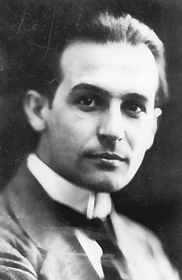 He travelled to Italy on the scholarship and lived in Florence and Rome for two years. Testimony of his work for this period are La Familia [The Family], Nacimiento de Venus [Birth of Venus] , Crepúsculo [Crepuscule], and Viejo Florentino [Old Florentine] . He decided that it would be more fruitful to see the architecture, museums and churches of other European countries than being locked up in an academy. He left Italy and travelled throughout England , Germany , Austria , Belgium , Holland , and France . In Paris, artist De La Cárcova, the scholarships supervisor, was waiting for him. He admonished him for not staying at the destination specified by the scholarship. In order to avoid a sanction he showed some drafts and notes he had made during his trip to De La Cárcova, who understood the importance of the insight and knowledge he had acquired.
He travelled to Italy on the scholarship and lived in Florence and Rome for two years. Testimony of his work for this period are La Familia [The Family], Nacimiento de Venus [Birth of Venus] , Crepúsculo [Crepuscule], and Viejo Florentino [Old Florentine] . He decided that it would be more fruitful to see the architecture, museums and churches of other European countries than being locked up in an academy. He left Italy and travelled throughout England , Germany , Austria , Belgium , Holland , and France . In Paris, artist De La Cárcova, the scholarships supervisor, was waiting for him. He admonished him for not staying at the destination specified by the scholarship. In order to avoid a sanction he showed some drafts and notes he had made during his trip to De La Cárcova, who understood the importance of the insight and knowledge he had acquired.
1912
Exhibited his work for the first time at the “Salón Nacional de Buenos Aires” [Buenos Aires National Exhibition].
1913
During this period he worked with artists Arístide Maillol and Antoine Bourdelle. He moved to Paris and settled in Montparnasse.
1914
Returned to Buenos Aires due to the First World War.
1916
He founded “Salon de Otoño” of La Plata [Autumn Exhibition Hall of La Plata].
1917
He embarked on his second trip to Europe . In Paris he studied with Arístide Maillol, Maurice Denis and Sérusier at “Académi Ranson” [Ranson Academy]. He travelled to Madrid and Barcelona where he exhibited his work.
1918
He returned to Buenos Aires . The sculptures from this period reflected the intention of simplification, of synthesis. Isis and Mujer Sentada [Sitting Woman] are examples of this tendency.
1920
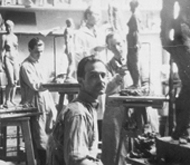 His third trip to Europe took place. He would remain there for the next thirty years. He settled in Paris and resumed his studies with Antoine Bourdelle, who made him understand architectural construction. Later on, he met painter André Lhote, who became his teacher for a short period of time. From this period are Pensativa [Pensive], Las Tres Bañistas [The Three Bathers], and Mujer del Tapado Grueso [Woman with the Thick Coat]. He exhibited uninterruptedly until 1929 at “Salon des Surindépendants” at the Tuileries.
His third trip to Europe took place. He would remain there for the next thirty years. He settled in Paris and resumed his studies with Antoine Bourdelle, who made him understand architectural construction. Later on, he met painter André Lhote, who became his teacher for a short period of time. From this period are Pensativa [Pensive], Las Tres Bañistas [The Three Bathers], and Mujer del Tapado Grueso [Woman with the Thick Coat]. He exhibited uninterruptedly until 1929 at “Salon des Surindépendants” at the Tuileries.
1921-1926
He became a member of the vanguard movement integrated by Juan Gris, Fernand Léger, Albert Gleizes, Constantin Brancusi, Pierre Reverdy, and later on, Le Corbusier. A creative and very productive period of his life commenced. He sculpted El Guitarrista [The Guitarist], El Acordeonista [The Accordionist], and El Hombre del Contrabajo [The Man with the Contrabass], cherished subject to the cubists artists. Then came La Ninfa Acostada [The Lying Nymph], El Dragón [The Dragon], and El Hombre del Lazo [The Man with the Lasso]. The most outstanding sculpture was Los Acróbatas [The Acrobats], which was the prelude of a new period where space was predominant. Making use of volume he modelled a series of open sculptures.
1922
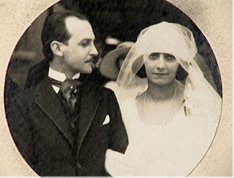 Married French painter Germaine Derbecq and opened his workshop at 12 rue St. Gilles.
Married French painter Germaine Derbecq and opened his workshop at 12 rue St. Gilles.
1925
Exhibited at “Galerie Vavin”, together with other members of the Parisian vanguardist movement.
1926
He was invited along with other French sculptors to collaborate in the construction of the pergola for the exhibition of “Les Arts Décoratifs” in Paris [Decorative Arts Exhibition] . He made the relief Lancelot and Genevieve, for which he was awarded the silver medal. This work of art was afterwards placed in the city of Etampes , at Seine-et-Oise, France, where is still found today. He was appointed Foreign Secretary of the Argentine Embassy in Paris, France. His beginnings as a member of the Diplomatic service drew him away from his workshop for three years.
1929
He was invited to participate in the First Modern Sculpture Exhibition organized by Teriade at the “Galerie Bernheim” together with the best-known artists of that time.
1930
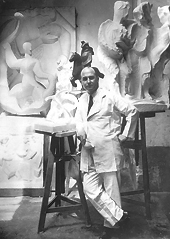 Resumed his sculpture work with Las Tres Gracias [The Three Graces]. He also made illustrations for the Quechua Drama “Ollantay”.
Resumed his sculpture work with Las Tres Gracias [The Three Graces]. He also made illustrations for the Quechua Drama “Ollantay”.
1931-1934
His work for this period included La Anunciación [The Annunciation], Cabeza de Apóstol [Apostle's Head], also called Cabeza de Profeta [Prophet's Head], and a series of torsos –seven in total; and Maternidad [Maternity].
1933
He was awarded the second prize at the Salón Nacional de Buenos Aires [Buenos Aires National Exhibition].
1934
His son Jorge was born.
1936
He moved his workshop to 40 rue Lauriston, near Plaza de l´Etoile.
1937
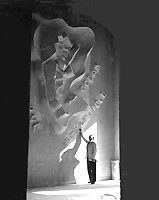 He received a request to make reliefs for the hall of the Argentine Pavilion at the Universal International Paris Exhibition. The request was to make two maps, one of Argentina and another one of the two hemispheres. He fulfilled the request with his sculpture conception, resulting in the works: "La Tierra Argentina" [ Argentine Land] and "Los Dos Hemisferios" [The Two Hemispheres]
He received a request to make reliefs for the hall of the Argentine Pavilion at the Universal International Paris Exhibition. The request was to make two maps, one of Argentina and another one of the two hemispheres. He fulfilled the request with his sculpture conception, resulting in the works: "La Tierra Argentina" [ Argentine Land] and "Los Dos Hemisferios" [The Two Hemispheres]
He was advisor to the Commissioner General of the Argentine Pavilion at the Universal International Paris Exhibition. Later on he was appointed Deputy Commissioner. He was also appointed Member of the High Jury for fine arts at the Exhibition and Officer of the Legion of Honour.
1939
First Class Secretary of Foreign Affairs. During the days previous to the war he was in charge of the repatriation section for Argentine nationals residing in France.
1940
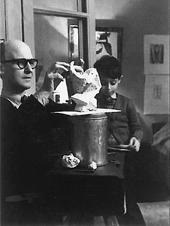 He and his family together with the Embassy staff had to relocate, first to Burgundy , then Biarritz , Bourboule, and finally Vichy . During the war period he worked with little resources. He drew, made models in clay, metal or cardboard. It was the time of his greatest structuring. He created Estructura Madre [Mother Structure] that he would use as the foundation for other sculptures.
He and his family together with the Embassy staff had to relocate, first to Burgundy , then Biarritz , Bourboule, and finally Vichy . During the war period he worked with little resources. He drew, made models in clay, metal or cardboard. It was the time of his greatest structuring. He created Estructura Madre [Mother Structure] that he would use as the foundation for other sculptures.
1945
With the liberation of Paris , he had to reinstate the Argentine Embassy back in this city. He would be in charge of rebuilding the house that belonged to General San Martin in Boulogne-Sur-Mer , which had been bombed during the war. He was reassigned and appointed Second Class Secretary of Foreign Affairs.
1946
He took part once more in the “Salon des Surindépendants” at the Tuileries, in Paris , which had been prohibited during the war.
1947
He participated in an exhibition at the “Galerie Denise-René” in Paris, together with Arp, Calder, Giacometti, Picasso and Laurens, among others. He was an observer delegate representing the Argentine government at UNESCO’s first meeting. He exhibited at the Pensée Francaiçe house, in the art exhibit “Sculpture in France since Rodin’s times”. He was appointed Head of the Consulate General of Argentina in Oslo . Meanwhile in Buenos Aires he had been awarded the first prize at the “Salón Nacional de Artes Plásticas” [National Exhibition of Fine Arts] for his work called El Dragón.
1949
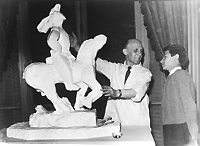 He was appointed Head of the Consulate General of Argentina in Athens , Greece . He donated thirty-one of his sculptures in order to open the “Museo de Arte Moderno de Buenos Aires” [ Museum of Modern Art of Buenos Aires] . He participated in the Latin American artists’ exhibit at “Maison de L’Unesco”.
He was appointed Head of the Consulate General of Argentina in Athens , Greece . He donated thirty-one of his sculptures in order to open the “Museo de Arte Moderno de Buenos Aires” [ Museum of Modern Art of Buenos Aires] . He participated in the Latin American artists’ exhibit at “Maison de L’Unesco”.
1951
He returned to Argentina and was appointed to the Directorship General of Foreign Affairs. He started sculptures that had previously remained as sketches, at the same time he sculpted the last version of Güemes.
1952
He participated at the “Venice International Biennale” by sending the sculpture El Pájaro [The Bird], the first of seven variations of his Estructura Madre.
1953
He organized “Exposición de Arte Contemporáneo Argentino” [Argentine Contemporary Art Exhibition] , later presented in Chile, Peru and Ecuador.
1954
He was a member of the organizing commission in charge of sending works of art to the Brussels International Exhibition.
1955
The Decree from the Argentine Government accepting his donation of thirty-one sculptures was published, assigning them to the “Museo Nacional de Bellas Artes” [National Museum of Fine Arts] . He organized the exhibition “Nuestro Tiempo” [Our Time] , funded by the Municipality of the City of Buenos Aires, and which brought together architecture, sculpture, painting, and urbanism. He exhibited two of his pieces, Torso Femenino [Feminine Torso], and Tierra Argentina [ Argentine Land ], at the “Musée d’Art Moderne” [ Museum of Modern Art ], in Paris.
1957
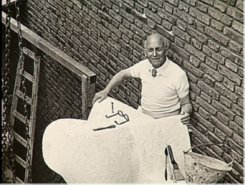 He participated in the Sao Paulo Art Biennial, with Construcción Espacial [Space Construction] and Proyección 8 [Projection 8].
He participated in the Sao Paulo Art Biennial, with Construcción Espacial [Space Construction] and Proyección 8 [Projection 8].
He organized the second exhibition “Nuestro Tiempo”.
Argentina ‘s Foreign Affairs appointed him First Class Secretary in the diplomatic service.
He received the Great Prize of Honour at the “Artes Plásticas de Mar del Plata ” [Fine arts of Mar del Plata], in the province of Buenos Aires .
Exhibited at the “Wildenstein Gallery”. An individual exhibit for which he got great reviews from the critics.
He sculpted two reliefs for the “Teatro General San Martín” [General San Martin Theatre], El Drama [Drama] and La Comedia [Comedy], requested by architect Mario Roberto Álvarez.
1958
He was sent to the Argentine Embassy in Brussels , Belgium. He was the Deputy Commissioner of the Argentine pavilion at the Brussels International Fair, and Vice-president of the Grand Jury of fine arts. He was also a member of the Superior Jury of the International Exhibition. The King of Belgium decorated him with the order of Leopold for his work in this country.
1961
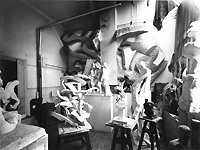 He was appointed Commissioner of the “Biennale des Arts” [Arts Biennial], in Paris . He was able to re-open his workshop on rue Lauriston. The city that gave him the best moments of his creative energy, and a group of close friends. It also enabled him to conceive art as a permanent formal, intellectual and spiritual challenge; and a systematic and rigorous search. He created sculptures with a new modelling technique using dirt or plasticine, as if they were fabric. From this period were Omega and the 8 Estudios [8 Studies] series.
He was appointed Commissioner of the “Biennale des Arts” [Arts Biennial], in Paris . He was able to re-open his workshop on rue Lauriston. The city that gave him the best moments of his creative energy, and a group of close friends. It also enabled him to conceive art as a permanent formal, intellectual and spiritual challenge; and a systematic and rigorous search. He created sculptures with a new modelling technique using dirt or plasticine, as if they were fabric. From this period were Omega and the 8 Estudios [8 Studies] series.
1962
He exhibited at the “Galerie Creuze” in Paris. “Pablo Manes and Thirty Argentines from the New Generation”. The “Musée D´art Moderne” in Paris acquired two of his pieces: El Guitarrista [The Guitarist] and Torso Femenino [Female Torso]. A serious illness would bring him back to Buenos Aires were he died on November 14.